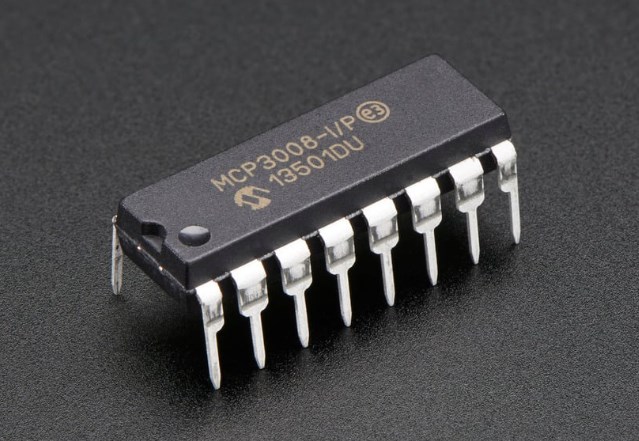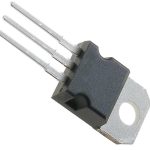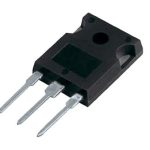The MCP3008 is a highly versatile and popular analog-to-digital converter (ADC) that opens up a world of possibilities in electronic projects. If you’re looking to interface analog sensors or signals with your microcontroller, the MCP3008 is an essential component to have in your toolkit. In this blog, we’ll introduce the MCP3008, exploring its features, functionality, and more useful information.
What is MCP3008?
The MCP3008 is an analog-to-digital converter (ADC) integrated circuit manufactured by Microchip Technology. It serves as a bridge between analog sensors and digital devices, allowing the conversion of analog signals into digital data that can be processed by microcontrollers like the Raspberry Pi.
How does the MCP3008 work?
The MCP3008 works by utilizing the Serial Peripheral Interface (SPI) protocol for communication. It has eight input channels, which can be used to connect various analog sensors. The analog signal from each channel is sampled and converted into a digital value through an internal successive approximation register (SAR). The converted digital data is then transmitted to the connected device, such as a Raspberry Pi, via the SPI interface.
Features
- Eight differential or single-ended input channels: These channels enable the connection of multiple analog sensors, providing flexibility in monitoring various physical quantities.
- 10-bit resolution: The MCP3008 can convert analog signals into 10-bit digital values, resulting in a total of 1024 discrete levels of measurement.
- High sample rate: It offers a maximum sample rate of 200 kilosamples per second (ksps), allowing for real-time monitoring of rapidly changing analog signals.
- SPI interface: The MCP3008 utilizes the SPI protocol for communication with other devices, enabling seamless integration with microcontrollers like the Raspberry Pi.
- Low power consumption: The ADC is designed to operate efficiently, consuming minimal power during operation.
Price of MCP3008
The price of the MCP3008 varies depending on factors such as the retailer, location, and quantity purchased. Generally, it is available at an affordable cost, typically ranging from around $2 to $5 per unit.
What is the difference between MCP3004 and MCP3008?
The main difference between the MCP3004 and MCP3008 lies in the number of input channels they offer. While the MCP3008 provides eight input channels, the MCP3004 offers only four. Both ADCs have the same 10-bit resolution and utilize the same SPI communication protocol. Therefore, the choice between MCP3004 and MCP3008 depends on the specific project requirements and the number of analog sensors that need to be connected.
How to read data from MCP3008?
To read data from the MCP3008, you need to communicate with it using the SPI protocol. This involves sending appropriate commands and receiving the converted digital data. You can accomplish this by utilizing libraries or programming languages that support SPI communication, such as Python with the spidev library.
By following the MCP3008’s datasheet and the corresponding library’s documentation, you can set up the communication, select the desired input channel, and retrieve the digital value from the ADC.
How to use MCP3008?
Using the MCP3008 involves the following steps:
- Connect the MCP3008 to your Raspberry Pi using jumper wires or a compatible module.
- Set up the SPI communication interface on the Raspberry Pi by enabling it in the configuration settings or using the appropriate software libraries.
- Write code or use existing libraries to establish communication with the MCP3008 via SPI.
- Configure the ADC by sending appropriate commands to select the desired input channel, reference voltage, and other settings.
- Read the converted digital values from the ADC and process them according to your application requirements.
- Repeat the reading process as needed, continuously or periodically, to monitor and analyze the analog signals.
How to connect MCP3008 to Raspberry Pi?
To connect the MCP3008 to a Raspberry Pi, follow these steps
- Identify the SPI pins on the Raspberry Pi’s GPIO header. These are usually labeled as MOSI (Master Out Slave In), MISO (Master In Slave Out), SCLK (Serial Clock), and CE0 (Chip Enable 0).
- Connect the corresponding SPI pins on the MCP3008 to the Raspberry Pi’s GPIO pins using jumper wires or a compatible module.
- Provide power to the MCP3008 by connecting its VDD pin to a suitable power source (e.g., 3.3V or 5V) and connecting its GND pin to the Raspberry Pi’s ground.
- Ensure that the Raspberry Pi has SPI enabled in its configuration settings or utilize software libraries to enable SPI communication.
- With the physical connections established, you can proceed with the software setup and coding to read data from the MCP3008 using SPI communication, as described earlier.

FAQs
Can we connect the analog sensor to Raspberry Pi?
Yes, it is indeed possible to connect analog sensors to the Raspberry Pi. However, since the Raspberry Pi primarily features digital input/output (I/O) pins, connecting analog sensors directly to it can pose a challenge. To overcome this limitation, an analog-to-digital converter (ADC) like the MCP3008 comes into play.
The MCP3008 acts as a bridge between the analog sensor and the Raspberry Pi, allowing for seamless conversion of analog signals into digital data that can be easily processed by the Pi.
What is the speed of MCP3008 SPI?
The MCP3008 utilizes the Serial Peripheral Interface (SPI) protocol for communication with the Raspberry Pi. In terms of speed, the maximum clock frequency supported by the MCP3008’s SPI interface is 3.6 MHz. This fast communication enables rapid data transfer between the ADC and the Raspberry Pi, ensuring real-time monitoring and accurate measurements.
Which type of ADC is MCP3008?
The MCP3008 is a type of analog-to-digital converter (ADC) commonly known as an 8-channel, 10-bit ADC. It offers eight input channels, enabling the conversion of up to eight analog signals into digital form. The 10-bit resolution means that the MCP3008 can provide a total of 1024 discrete digital values, allowing for precise measurement and analysis of analog signals.
What is the MCP3008 module for Raspberry Pi?
The MCP3008 module for Raspberry Pi is a compact circuit board specifically designed to interface the MCP3008 ADC with the Raspberry Pi. This module simplifies the connection process by providing headers and pins that match the corresponding GPIO (General Purpose Input/Output) pins on the Raspberry Pi. By attaching the MCP3008 module to the Raspberry Pi, users can easily access its powerful analog-to-digital conversion capabilities and integrate it seamlessly into their projects.
What is the sample rate of MCP3008?
The MCP3008 offers a sample rate that can reach up to 200 kilosamples per second (ksps). This means that the ADC can convert up to 200,000 analog samples into digital data every second. The high sample rate enables real-time monitoring and accurate capture of rapidly changing analog signals. Whether you’re measuring temperature, light intensity, or any other variable, the MCP3008’s impressive sample rate ensures you don’t miss any crucial data points.
Conclusion
In conclusion, the MCP3008 is a remarkable ADC that empowers electronics enthusiasts to convert analog signals to digital data with precision and ease. Its impressive features, wide compatibility, and straightforward integration make it a valuable tool for various applications. Whether you’re working on robotics, IoT devices, or any other project that requires reliable analog-to-digital conversion, the MCP3008 is a fantastic option to consider.



